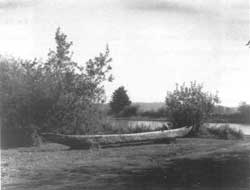|
Fort Clatsop
Administrative History |

|
CHAPTER EIGHT:
INTERPRETATION (continued)
Interpretation, 1955-1963

Dugout canoe at the canoe landing site.
(FOCL photo collection)
After the replica was finished and the Sesquicentennial over, OHS installed a chain link fence around the structure for security. OHS could not afford to hire anyone to be at the site year-round for its protection and interpretation and the society was already in the midst of trying to get Fort Clatsop transferred into federal ownership. For those reasons, OHS interpretation was limited. Burnby Bell, secretary of the Clatsop County Historical Society, handled all replica business for OHS. During the summers of 1956-1958, while the outcome of the legislative movement was pending, the society was able to hire someone to open the site during the day and be on-site for protection and maintenance. This person was responsible for opening the replica, maintaining the pit toilets, answering questions for visitors, handling a donation box, and selling small, miscellaneous souvenirs for the Clatsop County Historical Society.
From 1959 until 1963, while regional and memorial staff were absorbed in the various developments necessary to make Fort Clatsop a functioning unit of the NPS, actual interpretation remained limited. During 1961, the memorial hired a seasonal to be at the fort replica eight hours a day from July 13-September 9. From September to November, the seasonal was at the replica on the weekends. During the remainder of the winter, the replica remained locked. Available at the memorial was a brochure designed by the Astoria Chamber of Commerce that described Fort Clatsop and the Astoria Column.
Planning for the memorial's interpretive programs began with the site concept for the memorial and continued with the development of the memorial's visitor center exhibits and the rehabilitation of the fort replica. Planning also included researching and acquiring interpretive materials such as films, books for the memorial's library, and materials for the visitor center exhibits. The staff consisted of two employees until 1962, and in 1963 increased to four employees with one seasonal. For the first years under NPS management, the small staff was consumed with planning duties and construction.
A draft interpretive prospectus was completed by Park Historian Burnby Bell in 1961. In the prospectus, Bell stated that three methods would be used to present the story of the Lewis and Clark Expedition to the public. These were: visitor center exhibits, the reconstructed and furnished replica, and the area itself, which would have self-guiding trails and interpretive signs. Bell outlined twelve possible exhibit cases for the visitor center, which would include information about the geopolitical climate of the Expedition, the preparation and beginning of the Expedition, major events which occurred as the Expedition crossed the continent, time spent at Fort Clatsop, and the American Indian communities encountered along the route and on the Pacific Coast. Bell also called for a display of dugout canoes at the canoe landing site, with interpretive signs. While most of the ideas in the 1961 draft prospectus for the visitor center were used, the master plan and the historic structures report determined that the replica would be furnished only with the crude furnishings which would have been left behind by the Expedition. The display of dugout canoes at the canoe landing and the placement of wayside exhibit signs were not realized until after 1970.
| <<< Previous | <<< Contents >>> | Next >>> |
focl/adhi/adhi8a.htm
Last Updated: 20-Jan-2004